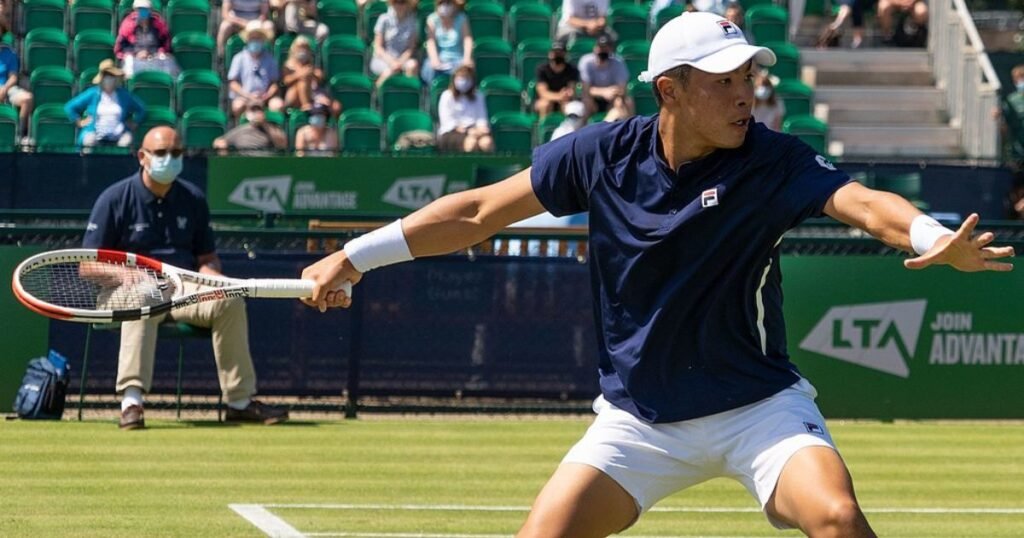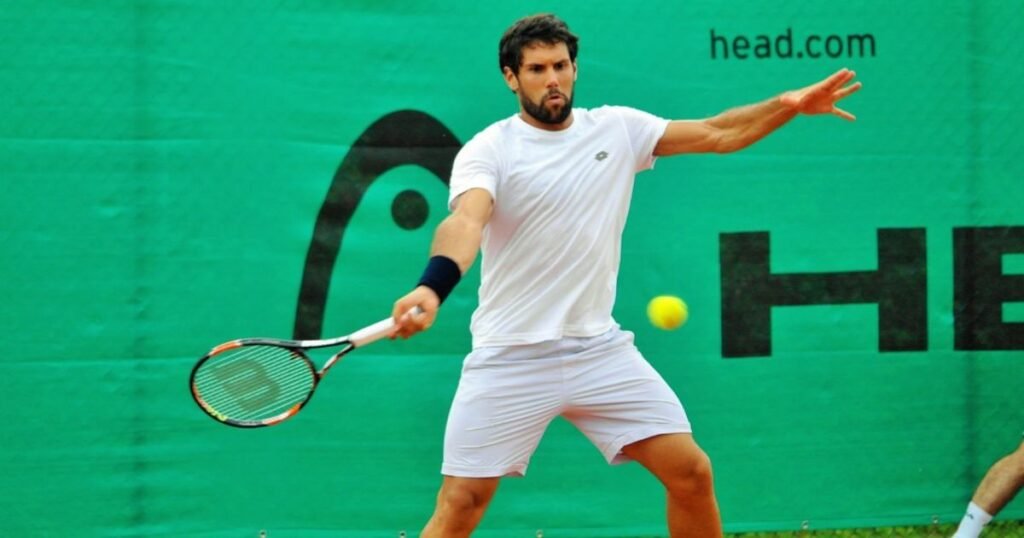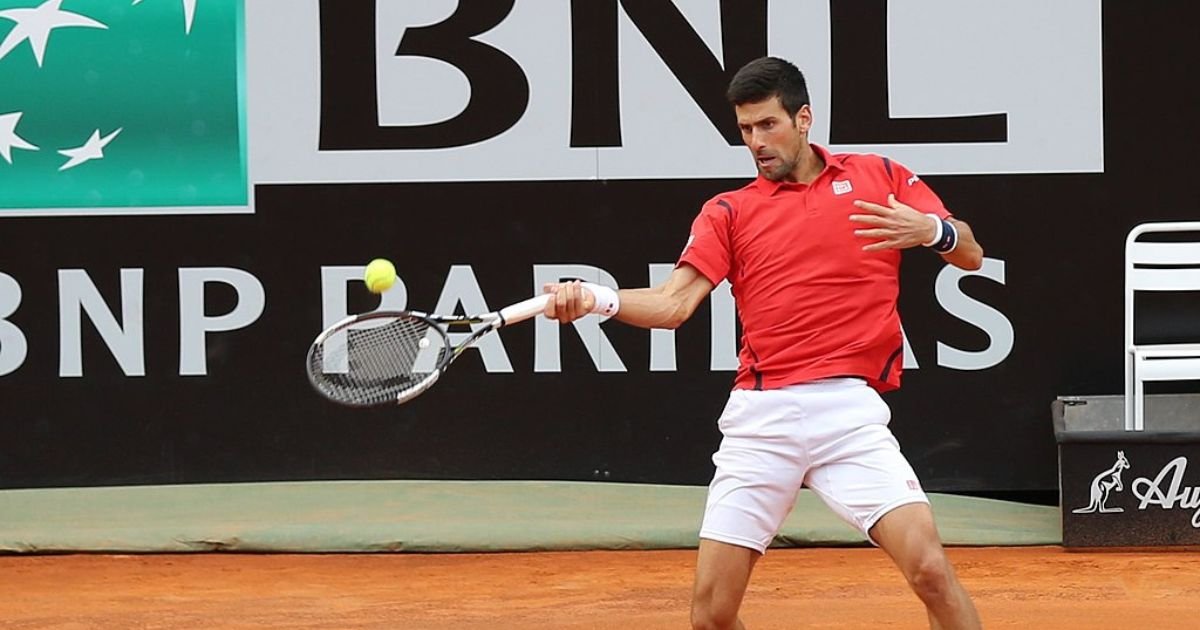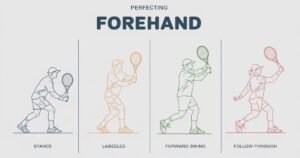Topspin forehand is one of the most important shots that can unlock a lot of offense because it also gives the players control of where the ball goes, and forces the rival to stand and receive the ball. Learning this technique may help make you the most aggressive and reliable player on the court. But you can’t hit with topspin and come out a great player, you also need to develop great forehand strength and accuracy.
Here’s a brief guide to some of the most important voices for the forehand that you will be able to use against your opponent in this article. The outlined strategies below will assist you in coming up with a vicious close effective forehand topspin, whether you’re a beginner or an experienced player.
You will get all the information you need in this article to help you master how to nail your topspin forehand and win your game. Wanna know how to improve your forehand? Here are the mechanics and tactics that will help you!
Table of Contents
Understanding the Topspin Forehand
Topsin is the amount by which the orientation of the tennis ball rotates from the vertical plane as it moves across the playing area and the amount by which dips steeply after crossing the net. Here the axial spin is imparted in a downward spinning motion for better control and the ball rises more when it hits the ground. The topspin forehand is today’s most important stroke because it offers the ability to hit the ball anywhere on the court while having more margin for mistakes.
It is an extremely effective shot when placed right because it allows aggressive play without sacrificing the ball’s position to go long. The forward speed of spin is directly proportional to the quickness at which the ball dips, making it a perfect weapon for pulling the opponent out of position.
Benefits of Using Topspin
Mastering topspin on your forehand comes with numerous benefits:
- Increased Control: The topspin forehand enables you to ‘hit out’ as hard as possible whereas there is added control regarding the whereabouts of the ball, on the court.
- Higher Bounce: Topspin makes the ball have a high bounce by making the ball kick at the moment it impacts the ground causing your opponent problems. This is particularly useful on clay courts because when the topspin shots that are made in this discipline of tennis land, they have to rise even higher.
- Margin of Safety: As compared to open stance and without topspin, topspin means that because of the natural downward incline you can aim higher across the net and still land it in bounds which in turn decreases the risk of hitting into the net.
- Consistency in Groundstrokes: Topspin works for the particular benefit of a player during the pressures like it provides consistent and steady impact in the game.
It is important to know these benefits in order to proceed to specific techniques for developing power and spin on a topspin forehand.
Proper Grip for Maximum Spin and Power
Eastern vs. Semi-Western Grip
The kind of grip you employ has a bearing on the amount of spin and power you can make on your forehand. The topspin forehands come in two basic grips known as the Eastern grip and the Semi-Western grip, which have their benefits.
Eastern Grip: This grip positions the knuckle of your first finger on the third bevel of the racket handle, Paste Page Image Here. The Eastern grip is employed by the rather flat-stroked players but it permits fairly adequate topspin. This grip allows for great variety and can be used for flat shots as well as for those for which topspin is desirable, but not as much spin might be attained as when using an eastern grip.
Semi-Western Grip: This one is preferred in causing heavy topspin to be produced and is used together with a penholder. The tip of your fourth finger rests on the base knuckle of your index finger, on the fourth bevel of the racket. The Semi-Western grip affords you the ability to brush up the back of the ball more easily thereby imparting more topspin on the ball but even at the same time allowing you to hit it very hard. It is popular with many modern players mainly due to flexibility in the middle power and spin areas.
Pros and Cons of Each Grip
Eastern Grip Pros:
- Easier to hit flatter shots.
- Good for grass or fast courts but also suitable for other surfaces as well.
- Generating a more comfortable changeover between forehand grip and backhand grip.
Eastern Grip Cons:
- Compared to other styles, less topspin.
- May make it difficult to handle high-bouncing balls.
Semi-Western Grip Pros:
- Is used to generate heavy topspin.
- I can only say that it is great for handling high-balled and slow surfaces such as clay.
- It often lets you be more aggressive from the baseline.
Semi-Western Grip Cons:
- Harder to hit flatter shots.
- They are less effective on hard ground such as grass or when used indoor.
How to Find the Right Grip for You
As for grip, it is exhaustively dependent on the player’s preference and his style of play. Here’s how you can try each one:
Eastern Grip:
- Tilt the handle of your racket in your left hand if you are right-handed and vice versa and ensure the strings are on the ground.
- Sit the base knuckle of the first finger in the right hand on the third bevel.
Semi-Western Grip:
- Stand with the strings part of the racket vertically for the exercise.
- Situate the base knuckle of your dominant hand’s index finger on the fourth bevel.
It is advisable to try out these two grips within practice and see which of the two provides comfort in additionally producing the preferred spin and power. It also means that as you go deeper in your practice, you may need to make slight changes depending on how you feel and the surface of the court used.
Footwork

The basic aspects of playing with great forehand technique involve the correct footwork. The second strategy is not easy if the positioning is not excellent; it is hard to have both power and spin simultaneously.
It puts you in a good position, to balance yourself, and to get power from your body to the ball. Indeed, irrespective of the perfection of a perfect swing, a wrong foot position leads to irregular shots, missed timing, and lost control.
Feet control is critical when it comes to producing spin-intensive forehands or rather festive moves and or counter forehands.
Step-by-Step Breakdown of Effective Footwork
Split-Step and Preparation
- Timing, therefore, is critical in every forehand because it takes a split step to get it started. As soon as your opponent hits the ball, make a little jump to the left or right on the toes. This permits you to respond fast and trend on any move.
- After the split step, follow the direction of the ball with the eyes. Thus the dancers start their first step towards the ball.
Positioning
- Early Setup: Ideally you should move into position before the ball bounces on the sand. This saves you time to change your strategy as well as to make preparations on how to hit the ball. The more alert one gets into position the better the shot balance as well as shot control will be.
- Distance from the Ball: Avoid coming too close like on the other extreme cowering over the ball or being too far from the ball. Standing at arm’s length from your body should enable you to freely make very powerful arm swings.
Weight Transfer for Power
- To make your topspin forehand even stronger you should transfer your weight from your back foot to your front foot during the motion. It is recommended that the weight of your body is placed on your back leg when getting ready for your shot.
- During the backswing, your weight should slightly move to the back leg, while on the forward swing transfer it back to the front leg. This weight transfer gives the additional momentum required to propel the ball with force and with the option of imparting a backspin of the ball.
Choosing the Right Stance: Open vs. Closed Stance
- Open Stance: This is because the feet are parallel to the baseline as part of a posture while in the open stance, you can develop power as well as spins from your lower body more so the legs and the hips. It is normally assumed by the modern players particularly in baseline exchanges as it provides the entry point as well as faster mobility.
- Closed Stance: In the closed stance your front foot is more sideward across the dominant front foot. It offers further advantages but such a position is not often employed during vigorous gameplay. But it is more useful for lower balls or when stepping on the court.
Balancing and Recovering After the Shot
After you have done the shot you are forced to get back to balance to build up for the next attacking sequence. Once you have followed through then return your feet back to the basic position, preparing your feet to move around for the next ball that you have been aiming at. Unlike other rallies, baseline rallies necessitate proper economy since you are on the move to initiate the next rally.
Mastering the Swing Path for Maximum Spin
Topspin forehand needs a low to high swing path which plays a vital role in producing forward rotation which gives topspin to the ball. In this motion, the initiate the swing from a position underneath the level of the ball, and as one strikes it, one sweeps up in order to impart rotation as the face of the racket is at a low altitude as you move to a high altitude during the swing.
Here’s a step-by-step breakdown of the low-to-high motion:
- Start Low: The initial setup that should be taken includes placing the head of the racket below the level of the ball. Bend your knees slightly to get lower as you’re doing this just to get under the ball.
- Brush Up on the Ball: While swinging forward, try to feel the reach of the racket towards the right and above the ball and through the back of it. This brushing motion is very important while creating topspin. The higher the force applied in the upward direction the more the rate of spinning that will be produced.
- Finish High: Only make high follow-through, generally over your opposite shoulder. In the event you gain a higher finish, the more topspin you get to create.
Contact Point and Timing
The contact point essentially is where the magic begins. Swinging at the ball at a certain point in front of the body helps in getting the power plus control on the direction of the shot. Here are key tips to master this:
- Ideal Contact Point: To generate maximum power and top-spin you should hit the ball in front of your body at a height of belly button level. In this case, contacting the ball too late or too early will also limit your ability to produce topspin and more often your hits will not be powerful or accurately controlled.
- Timing: Procrasturbation of time in tennis is usually fatal. In this type of style aim to strike it right at the highest point of bounce so that you can control your shot while putting spin on the ball.
Racket Face Angle
In order to produce topspin Murray’s racket face at the point of contact must be slightly closed. The closed racket face is when the top side of the racket is slightly angled forward so you can brush up on the ball to make it go forward.
- Closed Racket Face: That is necessary to generate topspin. If the surface or pattern of the racket face is too opened, the result will be much flatter, and less spin will be imparted. Tilt the racket face forward for maximum topspin and still be able to hit the ball with power.
Accelerating Through the Shot
Acceleration is needed if one has to generate power and spin. The higher the narrator’s swipe of this racket with correct form, the more spin and potency are achievable. Here are tips for accelerating through the shot:
- Relaxed Grip: Tense your bow hand but try and lock your fingers and wrist so that there is no tension at all in your grip during the stroke. A tight grip will decelerate your racket head resulting in a lower amount of spin. A looser hand position will enable a faster, freer swing – this is something that is crucial if the player is to produce topspin.
- Use Your Whole Body: So do not rely solely on the arm when producing the racket speed which is used in most shots. In order to generate the pace for the shot bend your core, legs, and hips and transfer your whole body weight into the shot.
Follow-through for Spin and Power
Your follow-through is the motion that follows after the hitting of the ball. In order to create topspin and also power in a forehand, a high follow-through is equally essential.
- Over-the-Shoulder Finish: When you are ready to complete the brush stroke, your racket will be over the opposite shoulder. This will assist you to have consistency in creating spin and get a better handle on being on the air.
- Follow-Through Direction: How you follow through will determine the direction through which the ball will go. When you follow through upward and outward, the ball will sail high over the net with a good deal of drop.
Using Body Rotation to Generate Power

Swinging of the arms is not enough for the generation of power on the topspin forehand, the body especially the core and hip are very important. A key aspect is rotation or body rotation to crank out maximum power and still possess control at the same time, or minimum spin at the proper time. In doing this, the body rotation forms an energy chain, from the legs to the core, the arm, and finally to the ball.
Here’s how you can use your body effectively:
- Legs: Power is created at grassroots levels starting from the base. Swing back rather than up: shifting your weight towards your front leg when you begin the swing. This movement lets the energy from your lower body transmit to the upper body.
- Hips: Swing in the front, and rotate your hips. Your hips should be moved towards the net to open up your body as well as power to the forehand.
- Core: Thus, make core muscle movements to assist in the head office controlling the rotation and giving energy to the shot. A strengthened core enables you to probably be able to balance your body mass more effectively while delivering force on the swing.
Step-by-Step Guide to Rotating for Power
Coiling During Preparation
- When you are getting ready for the shot turn your shoulders and hips to where they are parallel to the net. This coiling motion works sort of like a spring mechanism so that there is energy that is stored in the core, the legs, and the hips most of the time.
- Your non-dominant hand should be positioned towards the ball to help maintain balance and turn off the shoulders to a greater extent.
Uncoiling During the Swing
- When you start your forward swing, start to release pressure and tension in your body. In shooting you should rotate your shoulders and hips forward as you step into the ball. This particular movement of the organic mechanism aids in the production of considerable rotary force.
- The sooner you uncoil, the more energy you are going to be able to transfer to the ball, however, do not be in a hurry to do this as this can upset the rhythm you have.
Full Body Rotation
- When contacting the ball your hips and shoulders must be aligned towards the net. It is permissible for your body’s rotational motion to continue as you complete follow-through.
- You get more power on your racquet, and it also puts you in a position where you are easily ready for the next shot.
Power from the Ground Up
Somehow, weight transfer is crucial concerning using the body rotation to the maximum. Ideally, you should begin with your weight on the back leg during the preparatory position and toward your front leg when you are swinging in front. This weight transfer assists you in keeping your balance at the same time ensuring that you have the needed force to push the shot.
- Back Leg to Front Leg: Not to forget as you extend your legs, step with your back leg and shift to your front one. This motion puts more authority and speed behind the ball while giving it topspin as well.
Common Mistakes to Avoid
- Over-Rotation: However, rotating too much is not correct since it may land your shot in the opposite direction that you want. Pay extra attention to the fact that the rotation should be smooth and stop when your back is toward the net.
- Lack of Balance: Staying in the middle is the most important thing. If you sit too close to the ball or stand too far, your chances of a powerful and controllable shot will be gone. Be as wide as shoulder’s width apart with your feet apart and maintain a firm posture during the shot.
Follow-Through and Recovery
Follow-through is the last component of the forehand stroke though its significance is comparable to the preparation and the swing of the racket. Full and proper follow-through allows you to control your racquet, produce bottoms and topspin regularly, and be prepared for the next strike. If you do not follow through well enough, the topspin forehand will lead to a number of errors or even a lack of power.
A good follow-through helps:
- Maintain Direction: Continuing through seeing to it that your racket glides in the designating path as you aim at the ball.
- Generate Spin: The swing, or follow-through of the racket, as it moves upward is very important in putting topspin on your forehand.
- Absorb Impact: A nice fist follow-through reduces the impact pressure of striking the ball thus minimizing injury and stress.
Key Elements of a Proper Follow-Through
Racket Finish Position
- When you finish with your racket, it should be above and over your opposite shoulder and your other hand should also assist in balancing. A high finish helps to produce topspin and provides just the right position for a good powerful smash.
- Ensure that your racket gets a full smooth arc. Although that power and spin can be cured if you cut the follow-through short, your shot could become an inconsistent mess.
Body Alignment After the Shot
- Finally, when you complete the follow-through your entire body should be rotated along with your hips and shoulders facing the net direction. This assists in guaranteeing you have all the energy from the body into the shot.
- Do not interrupt your rotation; let your body continue the rotation until you complete the use of your forward momentum force.
Relaxation and Smoothness
- Stay as laid back as possible with follow-through. Stress strains the motion of the swing and may weaken spin as well as control. A relaxed finish helps so that the movements made for the next shot do not have stiff muscles and one’s body is ready to respond fast.
Quick Recovery for the Next Shot
This done, a contestant needs to get ready for the next rally or regroup for a new sequence since it may well be the focal point of some late change. A fast recovery tackles this problem perfectly by allowing you to be in charge of the situation should the opponent decide to return the ball.
Here’s how to recover efficiently:
Return to Ready Position
- After the follow-through, extend your racket back to the same position and stand in front of your body. This keeps you ready for the perception shot when it comes.
- Return to the central court zone (your recovery area) feet flexed, and knees loose.
Efficient Footwork
- Move your feet small and fast after hitting your forehand to get back into position. As for me, good footwork helps in keep balance to be prepared for an opponent’s move.
- If the opponent has made a rash move then you can be sure that the next response may come in the form of a weak shot.
Maintain Focus
- Additionally, keep your mind focused after shooting so that you can be ready for the return shot from your opponent. That way, you can come back into a point or another rally much stronger and the opponent would’ve had little or no chance.
Common Follow-through and Recovery Mistakes
- Stopping the Swing Too Early: Shortening the follow-through weakens your topspin as well as your power. Remember to ensure the body goes round full circle to avoid leaving out part of this stone’s formation.
- Slow Recovery: If you do not manage to get well in time, you are easy prey to the next move of your adversary. Be quick in a reaction after the forehand and retrieve a ready position as soon as possible.
Conclusion
It is important to note that in order to improve one’s topspin forehand there are a few key points that need to be employed in order to gain both power and spin. Player positioning, proper grip (if possible semi-western or western), being ready with the racket, and proper impact location. Take a low to high swing path, rotate your body well, make sure you complete the follow-through, and recover quickly off the ball.
The best way to really get better at the topspin forehand is by getting in as many reps as you can. It is important that these techniques are repeated and practiced continually, so spend time in drills that will challenge you.
Feel free to share your progress with us in the future! Feel free to drop your experience in the comments section below and check out our other articles about forehand techniques for more information.



Pingback: Learn the basics of semi western grip in 5 simple steps